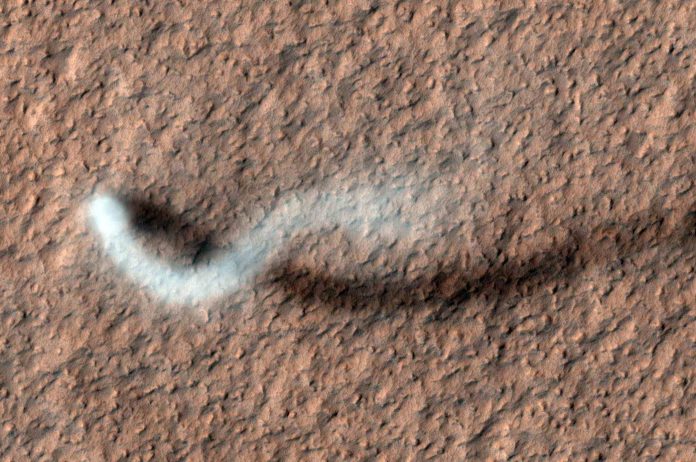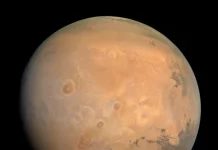
Mars is well known for its seasonal dust storms, which occur when the southern hemisphere experiences summer.
Periodically, these storms grow to engulf the entire planet and can last for months, wreaking havoc on robotic missions. Smaller regional storms are far more common on Mars, as are swirling columns of air and dust (aka. dust devils).
NASA’s Perseverance rover recently took pictures of several dust devils on the rim of the Jezero crater. Some of these images were stitched together to create a short video of a larger dust devil consuming a smaller one.
These images were taken by the rover’s navigation camera on January 25th when the rover was exploring the location called “Witch Hazel Hill.”
The rover was about 1 km (0.6 mi) from the two dust devils, the larger of which was approximately 65 m (210 ft) wide, while the smaller, trailing dust devil was roughly 5 m (16 ft).
The captures were part of an imaging experiment conducted by Perseverance’s science team to learn more about the planet’s atmospheric dynamics. Two other dust devils can also be seen in the background at the left and center of the video (shown below).
Like dust devils on Earth, these weather patterns are formed by rising and rotating air columns. They begin close to the ground, where the air is heated by contact with the warmer ground, then rises through the cooler air above.
Meanwhile, cooler air moves in to occupy the space near the surface, which causes the rising air to rotate and pick up speed. This process also kicks up dust from the surface, creating the swirling columns of dust and air that meteorologists call “convective vortices” or dust devils.
Mark Lemmon, a Perseverance scientist at the Space Science Institute (SSI), explained in a NASA press release:
“Convective vortices — aka dust devils — can be rather fiendish. These mini-twisters wander the surface of Mars, picking up dust as they go and lowering the visibility in their immediate area.
If two dust devils happen upon each other, they can either obliterate one another or merge, with the stronger one consuming the weaker. If you feel bad for the little devil in our latest video, it may give you some solace to know the larger perpetrator most likely met its own end a few minutes later. Dust devils on Mars only last about 10 minutes.”
Martian dust devils were first photographed from space by NASA’s Viking orbiters, which studied Mars in the 1970s. The Pathfinder mission, consisting of a lander and the Sojourner rover, was the first to image a dust devil on the surface.
Subsequent orbiters and rovers, like the Spirit and Opportunity rovers and the Mars Reconnaissance Orbiter (MRO), have taken images of these weather patterns from the surface and space. The Curiosity rover also took multiple images of dust devils in the Gale Crater, some of which were used to create a video.
Since landing in the Jezero Crater in 2021, Perseverance has also observed dust devils and even recorded what they sound like using its SuperCam microphone. Said Katie Stack Morgan, a project scientist for the Perseverance rover at NASA’s Jet Propulsion Laboratory:
“Dust devils play a significant role in Martian weather patterns. Dust devil study is important because these phenomena indicate atmospheric conditions, such as prevailing wind directions and speed, and are responsible for about half the dust in the Martian atmosphere.”
Learning more about these swirling columns of air is vital to understanding the dynamics of Mars’ atmosphere.
It could also lead to predictive models, allowing scientists to know where they might occur in advance.
Capturing these features is presently a matter of luck and timing, which is why Perseverance routinely monitors in all directions for them.
Written by Matthew Williams/Universe Today.



